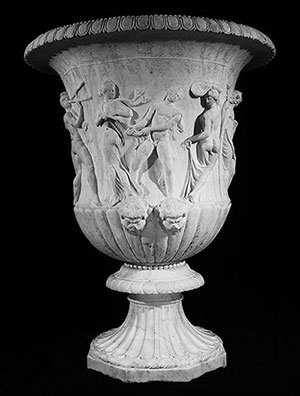Ornamental vocabulary and polychromy
Ornamental vocabulary

This side of the vase is depicted above the door to the left of the roll top-desk.
The ornamental vocabulary shows the dominant taste for antiquity in the late 18th century. The slender columns support an entablature delicately sculpted with beading, denticles and palm leaves. Their architectural order is very original: neither Ionic nor Corinthian but rather Egyptian or Etruscan. The pilasters are decorated with candelabra, foliation, beading, festoons, winged women, dolphins, eagles and caducei. The four bas-relief overdoors reproduce the sculpted decoration of the famous Borghese vase. The gracefulness of this purely decorative architecture is similar to that represented on Pompeian frescoes dating from the 1st century AD.
Polychromy
This decor’s original colours, typical of the Directoire and Consulat styles, were concealed with whitewash in the 19th century. The light yellow and off-white outlining the cornice echo the yellow false marble decorating the lower part of the columns and contrast with the blue imitation-wood door frames, which in turn harmonise with the blues and whites of the stucco evoking the famous stoneware produced in England by Wedgewood, then very popular.
Prompted by this success, the royal manufactory at Sèvres also produced biscuit porcelain in blue and white.
-
Panelling from the grand drawing Room of the hôtel de Serres
Paris, circa 1790-1795
sculpted and painted oak, moulded stucco
EUGÈNE BARRIOL bequest, 1938inv. 33897
-
Marriage of Cupid and Psyche
Medallion
WEDGWOOD & SONS fabrication, England, circa 1770
Stoneware
Gift of ALBERT BICHET, 1903This medallion is an example of the production of the manufacturer and illustrates its most brilliant period.
Room 24.inv. 10568 B